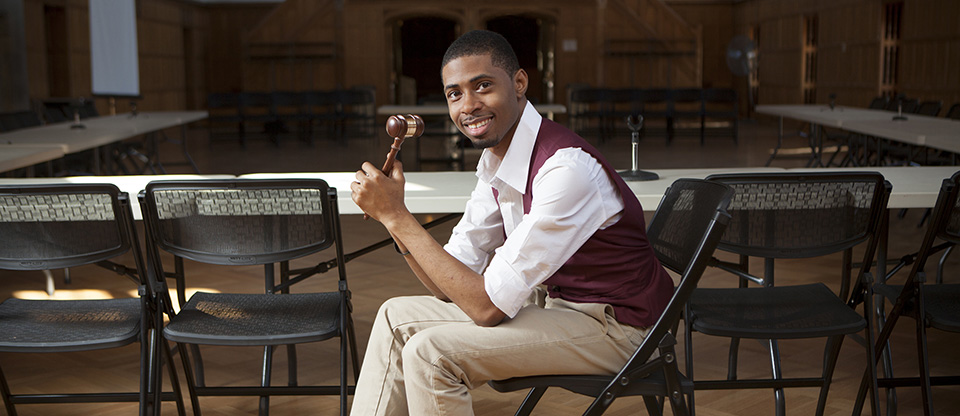
Class of 2014
President Ulysses Smith’s work for Student Assembly can go on day and night. (Email him and you’re guaranteed to hear back within 24 hours. More often than not, in just a few.)
If he’s not in class or speaking with students and administrators, you’re likely to find him in the undergraduate government’s office at 109 Day Hall—two floors below the university president’s office—or in its meeting space in the Memorial Room of Willard Straight Hall. The only time Smith is sure to take for himself—every day, without fail—is 30 minutes to watch the reality court show, Judge Judy, on YouTube.
His high school guidance counselor in Florida warned him that reaching for schools in the northeastern Ivy League would be a challenge, but he applied to Princeton, Yale, and Cornell, anyway. He did not want to go through life “regretting never having tried,” Smith says.
Cornell’s acceptance letter came in two weeks. He arrived on campus without so much as a campus visit. He came “on a whim and a prayer,” Smith recalls.
Mapping the future
Then his research began. Smith methodically read through a printed copy of Courses of Study and planned out the next 10 semesters—including the summers—creating a curriculum with two majors and two minors so he could explore his interrelated interests in urban design and planning along with access to education, democratic governance, and social justice.
“Ah, the joy of that book,” Smith recalls. “It was unbelievable to have all these opportunities here.”
While Courses of Study opened the door to the academic side of Cornell, it was his college’s vacant seat on the Student Assembly that gave Smith a place to test what he would learn in the classroom.
Open access for all
Access to shared governance—a concept he explored in case studies on how to involve residents in planning their own communities—seemed sorely lacking when he first joined the Assembly.
“People felt they had no access, that we were an unresponsive body, and I found it heartbreaking that they thought we weren’t listening,” Smith recalls. In going through Assembly documents he found there was no job description for elected representatives, who could, he says, “simply get elected and sit there and do a whole lot of nothing.”
So Smith wrote one, setting requirements that representatives meet with constituents and administrators at regular intervals and bring their concerns and requests back to the Assembly. In the next four years, Smith researched, created, and served in two new executive positions, vice president of outreach and vice president of diversity and inclusion. Each role helped him develop his leadership skills. His roles required him to conduct social events not only in his colleges but also in niche groups all across campus—and begin tough conversations about inclusion, race, gender identity, and ethnicity. He ensured every person’s point of view was articulated and listened to with respect.
Smith was surprised at how quickly the Assembly started to tackle hard issues that directly affected students—housing for transfer students; initiatives on sexual assault, safety, mental health; and effective means to engage new students with many different backgrounds. Native students also requested a resolution that renames Columbus Day to Indigenous People’s Day to recognize that Cornell was built on their ancestral lands.
“We often never knew these kinds of things because Assembly members had not been out there paying attention,” Smith says. Now they are.
In the process Smith put to work ideas and methods he was studying in government, education, and law and society courses—from the necessity to start with original documents to the range of inequities spawned by poor-quality education. His research project for his semester abroad with the Cornell in Rome program examined the political tactics of Roma Occupata. It also looked at highly effective social centers that were often founded by squatters.
Studying politics and people
During his years of service and study, Smith’s native capacity for empathy grew along with his political sophistication.
“It was key for me to begin understanding how people arrive at a particular perspective,” Smith says. “There’s no way I could have been elected Assembly president if people didn’t think I had a firm grasp on how to read others—people like me and people different from me.”
This understanding was furthered during the three years when he acted with Tapestry of Possibilities: Diversity at Cornell, an interactive theater group that gives first-year students an introduction to and tools for dealing with all the different types of people they’ll encounter on campus. Among his roles were a gay man, like himself, and a depressed man, very taboo in the black community.
“Once you start delving into character development, then you really begin to understand that people are very complex beings, and you appreciate the importance of going beyond physical differences,” Smith says.
All this insight will serve him well in his first career, as a public school judge, and, eventually, as a family court judge.
“That’s where you are most closely connected with people and where many precedents get set,” explains Smith, who has thoroughly researched the activities of judges at all levels. “Among other things, there’s a huge opportunity right now to examine what constitutes a family in light of same-sex marriage.”
For now he’ll make the most of his presidential year. “If you really believe in a system, you want to see it work—that’s why so many people watch Judge Judy, to see justice being served,” Smith explains. “I believe in the Assembly and want to see it accomplish its mission. It’ll be hard to leave behind.”
Learn more at http://as.cornell.edu and http://aap.cornell.edu.







